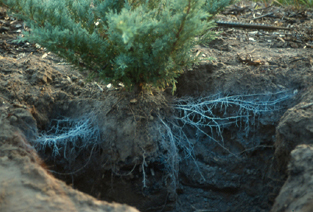Home > Urban/suburban design > Site modifications > Adding fill soil
Adding fill soil

Notice how new roots are formed mostly in the fill soil, not in the compacted subsoil.
Ideally, top (fill) soils brought onto the site should be mixed together before spreading. This helps prevent drainage problems caused by layering of different soil types. It is costly but will reduce landscape maintenance by providing a more uniform soil for root expansion.
If mixing is not practical, purchase fill soil that is as uniform as possible. Texture of fill soil should be about the same as or slightly coarser than texture of existing soil. At the very least, blend the interface between the two soils by tilling several inches of the fill soil into the existing soil.
These techniques help move water through the soil profile and reduce the likelihood of creating a perched water table. If different types of fill soil are used, the landscape will probably require more labor to maintain due to their different moisture and nutrient holding capacities, and poor internal drainage.
If loose, well aerated soil is spread over compacted soil, tree roots will grow mostly in the fill soil, not in the compacted subsoil. If the fill soil layer is less that 2 feet thick, a shallow root system will develop with few deep roots to provide anchorage for large-maturing trees.
Water is likely to pond in the lowest areas on the site. Plant wet site tolerant trees there. If fill soil is more than two feet thick, large maturing trees can probably be planted with little danger of blow over.

